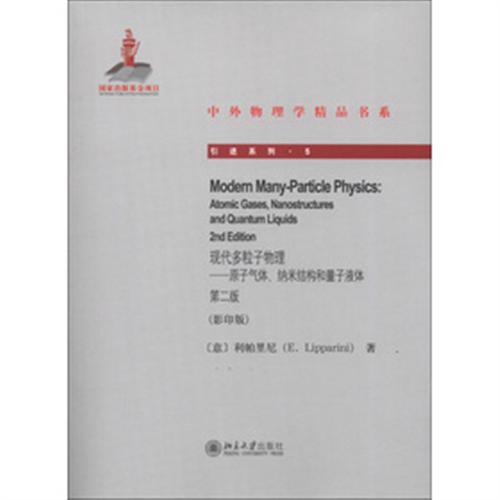首 页 >> 上架新书
现代多粒子物理:原子气体、纳米结构和量子液体(第2版) [2015-06-09] |
|
索书号 O4/Z698/v.5b 目录PrefacePreface to the Second Edition Chapter 1 The Independent-Particle Model 1.1 Introduction 1.2 Bosons 1.3 Fermions 1.4 Matrix Elements of One-Body Operators 1.5 Matrix Elements of Two-Body Operators 1.6 Density Matrices 1.7 The Ideal Bose Gas Confined in a Harmonic Potenti 1.8 The Fermi Gas 1.8.1 Excited States 1.8.2 Polarized Fermi Gas 1.8.3 The Fermi Gas in Two Dimensions with Rashba Interaction 1.9 Finite Temperature and Quasiparticles Chapter 2 The Hartree-Fock Theory 2.1 Introduction 2.2 The Hartree-Fock Method for Fermions 2.2.1 Examples of Physical Systems IYeated by the Hartree-Fock Method 2.2.2 Examples of Infinite Systems Treated by the Hartree-Fock Method 2.3 The Hartree-Fock Method for Bosons 2.4 The Gross-Pitaevskii Equations 2.5 Hartree-Fock in Second Quantization Language 2.6 Hartree-Fock at Finite Temperature 2.7 Hartree-Fock-Bogoliubov and BCS 2.8 Appendix: Second Quantization Chapter 3 The Brueckner-Hartree Fock Theory 3.1 Introduction 3.2 The Lippman-Schwinger Equation 3.3 The Bethe-Goldstone Equation 3.4 Examples of Application of the BHF Theory 3.4.1 The One-Dimensional Fermion System 3.4.2 Ultracold Highly Polarized Fermi Gases 3.5 Numerical Results of BHF Calculation in Different Systems 3.6 The g Matrix for the 2D Electron Gas 3.6.1 Decomposition in Partial Waves 3.6.2 The Separable Approximation 3.6.3 The g Matrix Expansion 3.6.4 Numerical Results and Discussion 3.7 The g Matrix for Confined Electron Systems 3.7.1 Effective Interaction in Confined Electron Systems 3.8 The BBP Method 3.8.1 Appendix Chapter 4 The Density Functional Theory 4.1 Introduction 4.2 The Density Functional Formalism 4.3 Examples of Application of the Density Functional Theory 4.3.1 The Thomas-Fermi Theory for the Atom 4.3.2 The Gross-Pitaevskii Theory for the Ground State of a Dilute Gas of Bosons 4.3.3 The Thomas-Fermi Approximation for the Fermi Gas Confined in a Harmonic Potential 4.4 The Kohn-Sham Equations 4.5 The Local Density Approximation for the Exchange-Correlation Energy 4.6 The Local Spin Density Approximation (LSDA) 4.7 Inclusion of Current Terms in the DFT (CDFT) 4.8 The Ensemble Density Functional Theory (EDFT) 4.9 The DFT for Strongly Correlated Systems: Nuclei and Helium 4.10 The DFT for Mixed Systems 4.11 Symmetries and Mean Field Theories Chapter 5 The Confined 2D Electron Gas in a Magnetic Field 5.1 Introduction 5.2 Quantum Dots in a Magnetic Field 5.2.1 The ωo》ωc Case 5.2.2 The ωc 》ωo Case 5.2.3 The Maximum Density Droplet (MDD) State 5.3 The Fractional Regime Chapter 6 Spin-Orbit Coupling in the Confined 2D Electron Gas Chapter 7 Monte Carlo Methods Chapter 8 The Linear Response Function Theory Chapter 9 The Linear Response Function in Different Models Chapter 10 Dynamic Correlations and the Response Function Chapter 11 The Hydrodynamic and Elastic Models Index |






